Traffic is expensive. Attention is fleeting. The real growth lever? Conversion.
Every click you earn has an associated cost, whether it’s paid, organic, or somewhere in between. But driving traffic is only half the equation. The brands winning in today’s landscape aren’t just great at acquisition—they’re relentless about optimizing what happens after the click.
That’s where Conversion Rate Optimization (CRO) comes in. And increasingly, that’s where AI (and AI-based CRO tools) are becoming a game-changer.
AI is reshaping how teams analyze user behavior, run experiments, personalize content, and make optimization decisions. It’s helping marketers move faster. It’s giving leadership clearer visibility into what’s working. And it’s turning CRO from a slow, manual process into a scalable growth engine.
This guide will walk you through:
- What AI-powered CRO actually means (without the hype)
- Why it matters to both your bottom line and your team’s efficiency
- The tools, prompts, and strategies top-performing teams are already using
- How to future-proof your CRO program for the next wave of AI innovation
If you want to streamline your CRO workflow while unlocking higher ROI from traffic, our guide can help you build a smarter, faster, and more scalable CRO system with AI as your copilot.
What Is AI Conversion Rate Optimization?
CRO is a methodology with the goal of increasing the percentage of users who take a desired action on your website, whether that be sign-ups, purchases, or demo requests. Traditionally, CRO involves using methods like A/B testing, incrementality testing, user surveys, heatmaps, and funnel analysis to identify and eliminate friction points in the user journey.
Bet here’s the catch: traditional CRO is manual, time-consuming, and often reactive. You’re relying on human analysis, limited sample sizes, and slow testing cycles to make improvements.
Using AI for CRO changes that.
When boosted with AI (using machine learning, predictive analytics, and automation), you’re able to analyze massive datasets, identify patterns in real user behavior, and generate insights that drive smarter, faster optimization decisions. This enables marketers and growth teams to personalize content, test variations, and respond to user intent in real-time, at a scale and speed far beyond our basic capabilities.
Key Differentiators of AI CRO
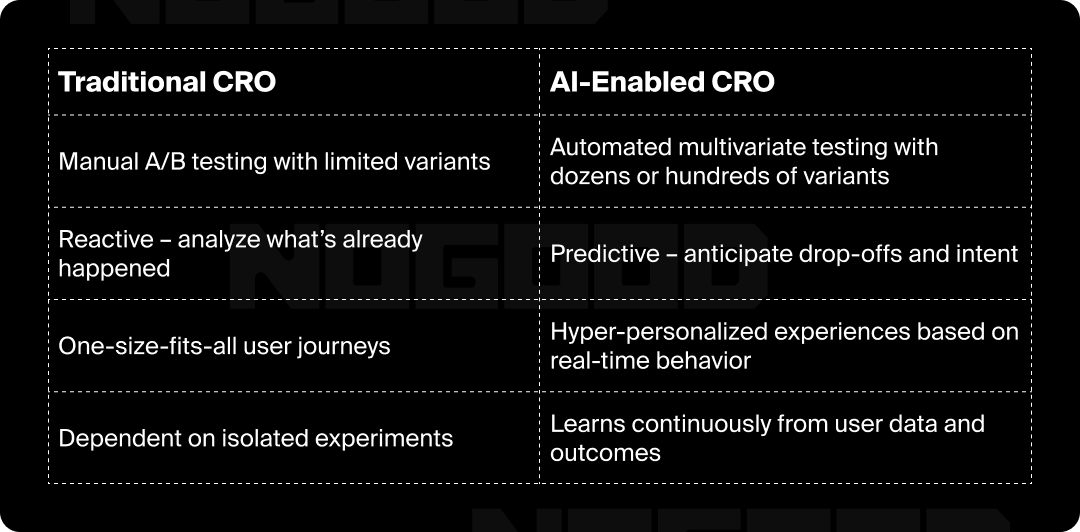
For marketers, this means less guesswork and more confidence in optimization decisions. For stakeholders, this means a faster time to ROI, improved customer experiences, and a scalable system for converting traffic into revenue.
In short: AI CRO doesn’t replace your strategy; it supercharges it.
Why AI-Driven CRO Matters for Growth
For forward-thinking marketing teams, getting traffic isn’t the problem, it’s converting that traffic into business outcomes. Despite rising ad costs and increased competition for attention, many companies still treat CRO as an afterthought, relying on occasional A/B testing or gut instincts to improve performance.
That’s where AI changes the game.
AI CRO unlocks faster insights, enables continuous optimization, and enhances personalization that can be adapted in real-time. Instead of reacting to problems after they occur, AI helps predict and prevent drop-offs in the conversion funnel; turning more visitors into leads, customers, and revenue.
For Marketing Teams
- Faster Insights, Less Guesswork: AI surfaces hidden trends in user behavior without needing to wait for test significance.
- Scale Without Burnout: Automate multivariate testing, content personalization, and landing page optimizations that would take weeks to do manually.
- Higher ROI on Campaigns: Make the most of your paid and organic traffic by optimizing the post-click experience with data-driven precision.
For Stakeholders & Decision Makers
- Accelerated Time-to-Value: AI reduces the time between campaign launch and performance lift, speeding up experimentation cycles and ROI realization.
- Better Resource Allocation: Fewer resources are wasted on low-impact tests or assumptions. AI helps prioritize what actually moves the needle.
- Sustainable, Compounding Growth: Instead of one-off wins, AI CRO builds systems that learn and improve continuously, turning short-term gains into long-term growth engines.
A New Standard for Optimization
AI CRO isn’t just a smarter way to optimize conversions, it’s the new baseline for performance marketing. Brands that implement AI in their CRO workflows are seeing measurable lifts in engagement, conversion rates, and customer lifetime value.
In a competitive landscape where customer expectations are rising, AI gives you the speed, scale, and precision to meet them; and outperforms competitors who are still relying on manual methods.
How to Use AI for Conversion Rate Optimization
AI doesn’t replace the need for a strong CRO strategy, it enhances it. But to fully leverage AI, you need the right foundation: clear goals, quality data, the right tools, and a consistent feedback loop.
Here’s how you can implement AI into your CRO workflow:
1. Define Your Conversion Goals
Before implementing any AI tool or workflow, you need to align on how you define success. Ask:
- Are you optimizing for lead form submissions, product purchases, demo requests, or newsletter sign-ups?
- Are you tracking micro-conversions (e.g., button clicks, scroll depth) in addition to macro ones?
For stakeholders, this means clarifying business KPIs tied to conversion performance like cost per acquisition (CPA), conversion rate by channel, or average revenue per visitor.
Setting clear, measurable goals ensures your AI models optimize for the right outcomes and that your team can track progress over time.
2. Centralize & Clean Your Data
AI models are only as good as the data they ingest. To power effective AI conversion rate optimization, you’ll need to centralize behavioral and performance data across platforms:
- Quantitative data from tools like Google Analytics, Mixpanel, or Amplitude
- Qualitative data from heatmaps, session recordings, and on-site surveys
- CRM data to track post-conversion actions and revenue attribution
Then, clean that data:
- Remove noise and outliers (e.g., bot traffic, internal sessions)
- Standardize naming conventions for events
- Ensure your tracking is firing consistently
This enables smarter segmentation and personalizations and means the insights AI spits out can be trusted and used to inform high-stakes decisions.
3. Select the Right AI Tools for Your Funnel Stage
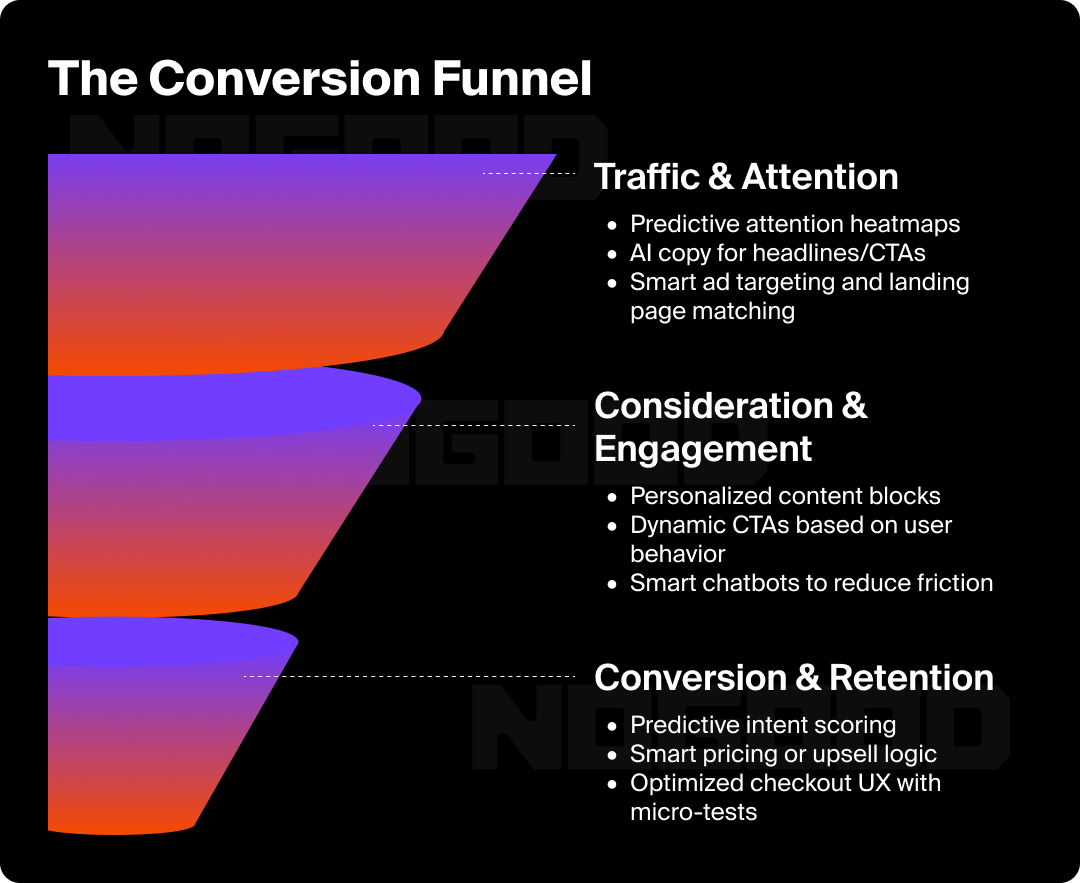
Not every AI tool fits every business. To avoid overkill (or underperformance), match your CRO tools to where they’ll have the most impact in the funnel.
Top of Funnel:
- AI-generated landing pages (e.g., Unbounce Smart Builder)
- Predictive attention mapping (e.g., Attention Insight)
- AI copywriting for headlines and CTAs (e.g., ChatGPT, Jasper AI)
Mid-Funnel:
- Personalization engines (e.g., Mutiny, Adobe Target)
- Smart CTAs based on user behavior
- On-site chatbot assistants powered by LLMs
Bottom of Funnel:
- Predictive analytics for pricing and upsells
- Funnel testing with AI-based prioritization (e.g., Evolv AI)
- Email subject line testing and personalization (e.g., Persado)
Pay attention to tool interoperability (how well tools integrate across marketing and product stacks) and cost-to-impact ratio.
4. Apply AI Prompts & Workflows (for ChatGPT, Jasper, etc.)
AI shouldn’t live on standalone platforms. Use it to actively collaborate with it through prompt-based tools like ChatGPT.
Examples:
- Landing Page Auditing: “Analyze this landing page for UX and copy elements that may hurt conversions.”
- CTA Ideation: “Generate 10 high-converting CTA variations for a freemium SaaS pricing page.”
- Objection Handling: “List the top objections for [product] and suggest ways to overcome them in copy.”
- Funnel Optimization Strategy: “Outline a 3-step CRO plan for a DTC brand with high traffic and low conversion.”
With these prompts you can build repeatable workflows while benefiting from consistent insights, faster iteration cycles, and fewer bottlenecks around teams.
5. Analyze Results, Iterate & Scale
Once your AI CRO system is in motion, focus your shift to continuous improvement. AI can accelerate learning, but your team still needs to apply them strategically.
- Review performance weekly or bi-weekly.
- Use dashboards to monitor test results, user behavior changes, and lift in conversion KPIs.
- Refine your experiments based on what works and scale them across pages or audience segments.
This means building a repeatable, compounding growth system rather than chasing one-off wins. It also means less time testing assumptions, and more time optimizing what actually moves the needle.
Best AI Tools for Conversion Rate Optimization
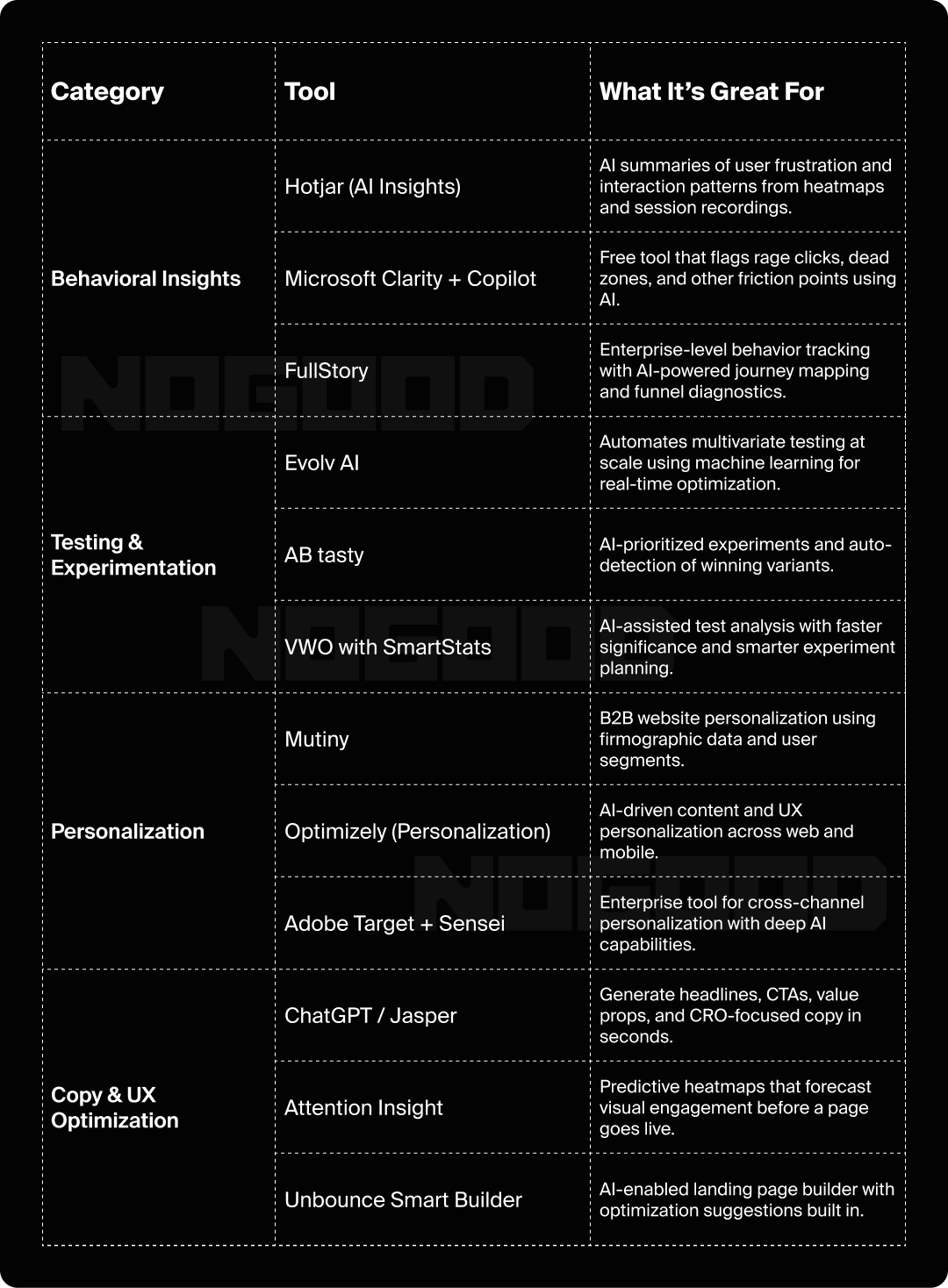
Tools powered by AI for CRO come in many shapes. Some help you understand your users more deeply, while others help you personalize the experience, test changes, and optimize UX and copy. Choosing the right mix depends on your goals, your team’s workflows, and where you’re seeing drop-off in the conversion funnel.
Here’s a breakdown of some valuable AI tools for CRO, grouped by function:
AI for Behavioral Insights
These tools help you understand how users interact with your website or product—what they click, where they hesitate, and what causes them to bounce. AI enhances these tools by surfacing patterns and insights automatically, eliminating hours of manual analysis.
Tools to Try:
- Hotjar (AI Insights): Combines heatmaps and session recordings with AI-generated summaries of user frustration signals and behavior trends.
- Microsoft Clarity + Copilot: Free tool that uses AI to identify rage clicks, dead zones, and usability issues across high-traffic pages.
- FullStory: Enterprise-grade session tracking with AI-powered journey mapping and funnel analysis.
Why It Matters:
Behavioral insight tools powered by AI help marketing teams detect drop-off points and friction in real time, enabling faster optimizations and better user experiences without waiting for test results.
AI for Testing & Experimentation
Testing is the foundation of any good CRO program. These tools allow you to automate A/B and multivariate testing, prioritize experiments based on potential impact, and run continuous optimizations at scale.
Tools to Try:
- Evolv AI: Dynamically tests hundreds of content and design variations using machine learning to optimize experiences in real time.
- AB Tasty: Offers AI-powered experiment targeting, automatic winner detection, and predictive conversion scoring.
- VWO’s SmartStats: Uses Bayesian statistics and AI-driven analysis to deliver faster, more statistically confident test results.
These tools reduce the risk and cost of experimentations. They can help you increase testing velocity and reveal deeper insights about what actually drives conversions.
AI for Personalization
One-size-fits-all content no longer works. AI personalization tools help you tailor messaging, offers, and UX elements based on user behavior, segment, or intent, boosting engagement and conversion rates across the funnel.
Tools to Try:
- Mutiny: Designed for B2B marketers; creates personalized headlines, CTAs, and sections based on firmographic data and user segments.
- Optimizely (Personalization): Combines experimentation with AI-driven content delivery based on behavioral data and traffic source.
- Adobe Target + Sensei: Enterprise-grade personalization engine that leverages Adobe’s AI platform to optimize UX across channels.
Why It Matters:
Personalization delivers higher ROI per visitor by aligning experiences with user expectations leading to lower bounce rates, longer session durations, and more conversions.
AI for Copy & UX Optimization
These tools assist in generating and refining copy, designing landing pages, or predicting how users will visually interact with content—all powered by AI.
Tools to Try:
- ChatGPT / Jasper: Generate CRO-focused content—headlines, CTA variations, value props, product descriptions, and objection-handling copy.
- Attention Insight: Aptly named, uses AI-based heatmaps to predict how users will engage with your page before you launch it, ideal for pre-test design evaluation.
- Unbounce Smart Builder: Leverages AI to build and optimize landing pages automatically, with suggestions for layout, copy, and CTAs.
Why It Matters:
These tools help you save hours of creative ideation while avoiding guesswork. This means you benefit from faster campaign launches and more consistent, conversion-optimized messaging.
AI Prompts for CRO (& What They Can Unlock)
Despite the recommendations given above, you don’t actually need to implement a new platform to start using AI for CRO. Tools like ChatGPT, Jasper, or Claude can act as on-demand strategists, copywriters, and UX analysts—especially if you know what to ask.
Below are high-impact prompt categories tailored for different stages of the CRO process. These can help marketers move faster, uncover insights, and generate conversion-focused assets while keeping human oversight in the loop.
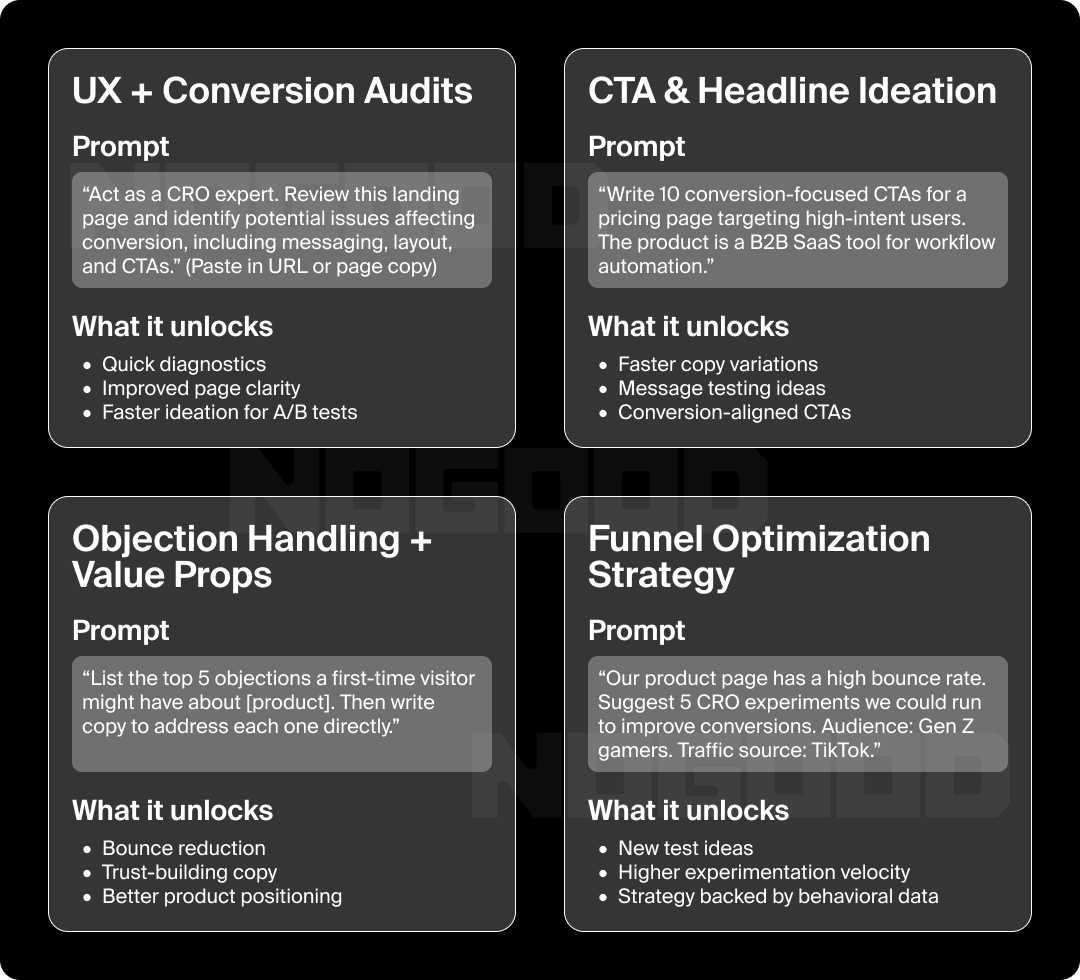
UX + Conversion Audits
Use AI to quickly scan pages or funnels for issues related to clarity, friction, or hierarchy.
Prompt:
“Act as a CRO expert. Review this landing page and identify potential issues affecting conversion, including messaging, layout, and CTAs. The goal is to improve signups.”
(Paste in URL or copy)
What It Unlocks:
- Faster page-level diagnostics
- Non-obvious friction points
- Suggestions for improvement in seconds
CTA & Headline Ideation
Ask AI to generate headline and CTA variations that align with different user intents.
Prompt:
“Write 10 conversion-focused CTAs for a pricing page targeting high-intent users. The product is a B2B SaaS tool for workflow automation.”
Pro tip: Better yet, give the LLM context into the product by prefacing the prompt with a “mini-training”.
What It Unlocks:
- Fresh copy ideas
- Intent-aligned messaging
- Faster testing cycles
Objection Handling & Value Props
Use AI to help articulate your product’s value in ways that reduce bounce or hesitation.
Prompt:
“List the top 5 objections a first-time visitor might have about [product]. Then write content to address each one directly.”
What It Unlocks:
- Messaging that removes friction
- Copy aligned to actual user concerns
- Better conversion from landing pages and ads
Funnel Optimization Strategy
For broader strategic thinking, AI can help ideate new CRO experiments based on your data.
Prompt:
“Our product page has a high bounce rate. Suggest 5 CRO experiments we could run to improve conversions. Audience: Gen Z gamers. Traffic source: TikTok.” and paste the URL to the product page.
What It Unlocks:
- Faster brainstorming
- Hypotheses grounded in behavior and intent
- Jumpstart for experimentation roadmaps
Bonus: Turn Prompts Into Repeatable Workflows
Once you identify which prompts drive results, build internal workflows around them—weekly audits, monthly campaign pre-launch checks, or even stakeholder reports.
Pro tip: Document winning prompts in a shared playbook so your whole team can use and refine them.
Will AI Replace CRO Teams?
The short answer? No.
AI may be transforming how we approach conversion rate optimization, but it’s not here to replace your team. Instead, it’s augmenting their abilities, automating repetitive tasks, and enabling faster, more informed decision-making.
Why Human-Centered CRO Still Matters
While AI can analyze behavior patterns, generate copy, and run multivariate tests at scale, it lacks the contextual intelligence that experienced marketers bring to the table. Things like brand voice, emotional nuance, user psychology, and business strategy can’t (yet) be fully automated.
What humans do best:
- Interpreting results with business context
- Prioritizing experiments aligned to company goals
- Crafting emotionally resonant messaging
- Spotting brand or UX misalignment AI might miss
- Bringing cross-functional insights into the CRO process
What AI Can Replace (& Should)

That said, AI is already eliminating much of the manual, repetitive, and low-leverage work that slows CRO teams down:
- Sorting through thousands of session recordings
- Manually calculating statistical significance in tests
- Writing endless headline or CTA variations
- Running one-variable-at-a-time A/B tests
- Creating user segments from scratch
By offloading these tasks, AI frees up your CRO team to focus on what actually moves the needle: strategy, storytelling, and experimentation velocity.
The New CRO Stack: Humans + Machines
Think of AI not as a replacement, but as a force multiplier. It allows small teams to scale insights, test more, learn faster, and ultimately deliver more value.
For stakeholders, that means:
- Lower costs to acquire and convert customers
- Faster execution on high-impact optimizations
- Stronger alignment between CRO and business goals
For marketers, it means:
- Less grunt work, more creative thinking
- Smarter testing with clearer hypotheses
- Continuous improvement without burnout
Bottom line: AI won’t replace CRO teams, but CRO teams that use AI effectively will absolutely replace the ones that don’t.
What’s the Future of AI CRO?
AI has already shifted how we test, personalize, and optimize, but we’re still early in the curve. The next phase of AI-powered CRO will move beyond automation and into anticipation—predicting user needs, adapting in real time, and driving personalized experiences at scale.
Here’s what the future of AI CRO is shaping up to look like:
1. Real-Time Buyer Intent Scoring
AI will soon be able to detect not just what a user is doing, but why. By combining behavioral signals, traffic source data, and historical trends, CRO platforms will assign real-time “intent scores” to each visitor and serve dynamic experiences accordingly.
What This Unlocks:
- Smarter segmentation on the fly
- Dynamic personalization based on likelihood to convert
- Better prioritization of high-intent leads for sales teams
2. Fully Adaptive Experiences
Imagine a landing page that rewrites itself based on who’s viewing it, not just personalized CTAs, but restructured layouts, value props, and even visuals tailored to user type.
This kind of AI-driven, composable UX is already being tested by cutting-edge CRO platforms and will soon be the norm.
What This Unlocks:
- Hyper-personalized journeys
- Higher engagement and time on page
- Reduced bounce and friction
3. Predictive Experimentation & Test Suggestion Engines
Instead of choosing which A/B tests to run manually, AI will proactively suggest experiments based on performance trends, user behavior, and statistical models. Some platforms already offer this at a basic level, but the next generation will include:
- Auto-prioritized testing roadmaps
- Suggested variables to test (CTA, form layout, pricing)
- Predicted uplift based on historical data
What This Unlocks:
- Higher experimentation velocity
- Better test ROI
- Less wasted effort on low-impact ideas
4. AI-Powered Cross-Channel Optimization
As AI becomes more multimodal and integrated, CRO won’t be limited to your website. Expect to see AI unifying conversion strategy across:
- Landing pages
- Email flows
- Chatbots
- Ad creative
- Product onboarding
The Result: A seamless, intelligently optimized user experience from first click to post-conversion, and better data continuity across the journey.
5. Strategic AI Copilots for CRO Teams
The rise of AI copilots means CRO strategists will soon have AI-powered assistants that do more than just answer prompts—they’ll proactively surface insights, detect anomalies, and even brief your team on what to do next.
Think: “Your lead gen form dropped conversions by 12% this week. Want to launch a form length test?”
What This Unlocks:
- Autonomous monitoring
- Proactive optimization
- Continuous, compounding growth
Why AI for CRO Matters Now
Teams that embrace AI now will build the infrastructure—and habits—needed to stay competitive as the space accelerates. Those who delay will be stuck playing catch-up, testing manually while others are optimizing in real time.
The future of CRO isn’t just faster or cheaper, it’s smarter.
And it’s already started.
How Do You Optimize Conversion Rates Today?
With all the talk about AI, it’s easy to forget: at its core, CRO is still about understanding your users and removing barriers to action. AI simply gives you the tools to do that faster, smarter, and at scale.
Here’s how modern, high-performing teams are approaching conversion rate optimization today with AI as an integrated part of the process:
1. Start With a Clear Goal, Not a Tool
CRO isn’t about using the flashiest software, it’s about aligning your optimization efforts to real business goals.
- Are you trying to reduce bounce rates on your pricing page?
- Increase demo signups from mobile traffic?
- Improve email opt-ins from your blog?
Define the conversion you want, then work backward with AI tools and tactics to support that outcome.
2. Combine Quantitative & Qualitative Data
Yes, AI can analyze heatmaps, click data, and funnel drop-offs in seconds, but don’t lose the human element.
- Use session recordings and user interviews to understand why users aren’t converting.
- Pair those insights with AI-generated summaries or predictive analytics for a full picture of behavior.
This dual approach ensures you’re optimizing for what people actually need, not just what the data suggests.
3. Test Continuously, Not Occasionally
CRO is an ongoing process of learning and refinement.
- AI tools like Evolv or VWO can run multivariate and continuous tests automatically.
- Prompt-based tools like ChatGPT can help ideate faster and eliminate testing bottlenecks.
The teams winning today are the ones running more experiments, more often, with faster learning cycles.
4. Optimize for the Entire Journey
Your conversion doesn’t happen in isolation, it’s part of a broader user experience. AI allows you to optimize across the entire funnel:
- Use predictive tools to personalize landing pages
- Deploy AI chatbots to guide users through hesitation points
- Test messaging variations in email, ads, and in-product onboarding flows
Today’s best CRO strategies are cross-channel, cross-touchpoint, and customer-first.
5. Prioritize Impact, Not Just Activity
Running tests for the sake of testing won’t drive growth. Use AI tools to prioritize experiments with the highest potential ROI.
- Which tests affect revenue-generating pages?
- Where is user intent highest, but conversion lowest?
- What can you automate or scale with AI?
CRO today is about focus, not just volume.
Final Thought: AI Is Your Accelerator, Strategy Is Still the Driver
AI can’t tell you what your users value most. It can’t replace human empathy, intuition, or brand judgment. But it can help you test faster, see patterns you might miss, and scale what’s working, faster than ever before.
The teams that blend human strategy with AI execution are the ones seeing meaningful, measurable, and compounding conversion growth.
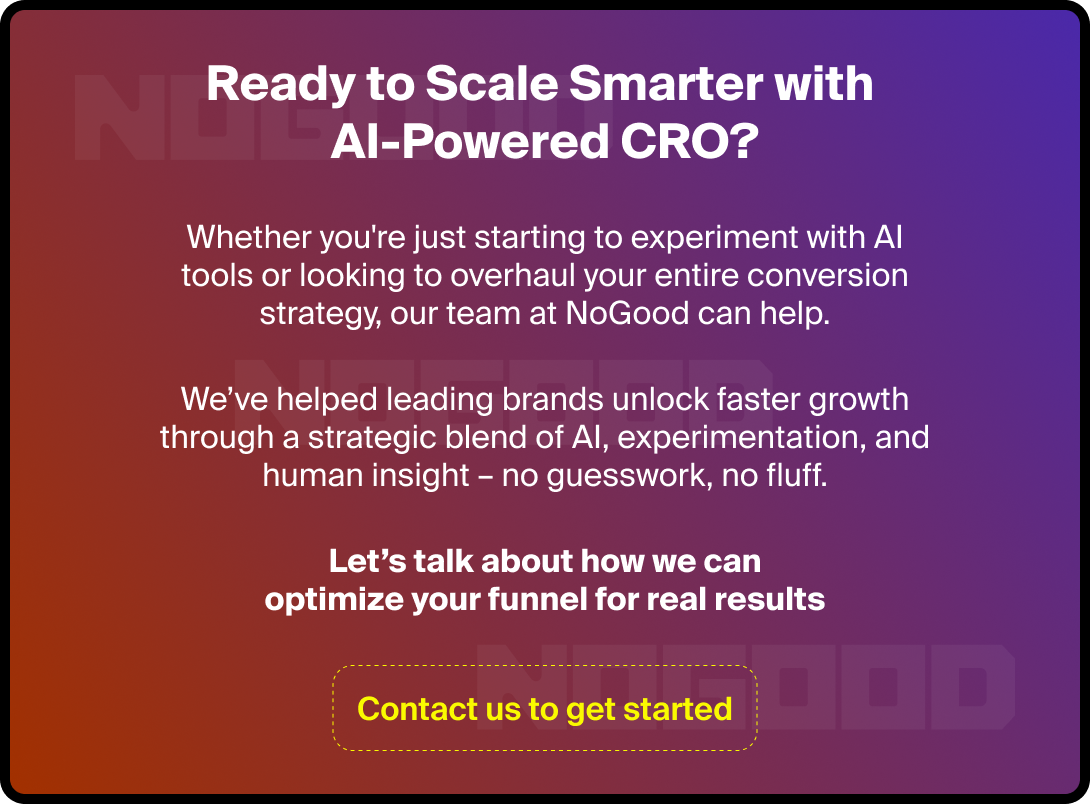
Let AI Do the Heavy Lifting
The future of conversion isn’t about working harder, it’s about working smarter. AI offers us the tools to move faster, test more, and optimize with precision. It also unlocks better performance, higher ROI, and systems that scale without burning out your team.
But technology alone isn’t the differentiator.
The real edge comes from how you use it—combining human insight with machine intelligence to understand your users, anticipate their needs, and remove every barrier between curiosity and conversion.
AI isn’t here to replace your CRO team. It’s here to handle the heavy lifting so your team can focus on strategy, creativity, and growth.






